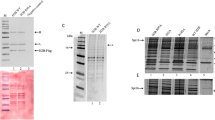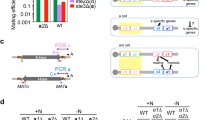Abstract
The transcriptional activator Ste12p is a key component of the yeast pheromone response pathway: phosphorylated as a consequence of signal transduction, it activates transcription of genes that promote mating and the subsequent fusion of the two cell types a and α. Activation by Ste12p requires three types of protein-protein interaction between DNA-binding activator proteins: (1) Ste12p by itself can induce non-cell-type-specific genes involved in mating; (2) cooperation of the transactivator Mcm1p with Ste12p induces a-specific genes; and (3) formation of a complex of the activator proteins Mcm1p and α1 (a transcriptional activator of α-specific genes) with Ste12p is believed to induce α-specific genes. We isolated and characterized a partially functional ste12 allele (ste12-T50), that is defective only in the activation of α-specific genes. ste12-T50 was isolated as a second-site mutation conferring the a mating phenotype on matα2 mutant cells. In matα2 cells, where due to the lack of repressor, α2, both sets of cell-type-specific genes are expressed, ste12-T50 apparently tips the balance in favor of a-specific gene expression. Thus, matα2 ste12-T50 cells mate like a cells. Additional ste12 mutants that confer the a mating phenotype on matα2 cells have also been isolated.
Similar content being viewed by others
References
Bender A, Sprague GF Jr (1986) Yeast peptide pheromones, a-factor and α-factor, activate a common response mechanism in their target cells. Cell 47:929–937
Bender A, Sprague GF Jr (1987) MATα1 protein, a yeast transcription activator, binds synergistically with a second protein to a set of cell-type-specific genes. Cell 50:681–691
Bender A, Sprague GF Jr (1989) Pheromones and pheromone receptors are the primary determinants of mating specificity in the yeast Saccharomyces cerevisiae. Genetics 121:463–476
Boeke JD, LaCroute F, Fink GR (1984) A positive selection for mutants lacking orotidine-5′-phosphate decarboxylase activity in yeast: 5-fluoroorotic acid resistance. Mol Gen Genet 197: 345–346
Burkholder AC, Hartwell LH (1985) The yeast α-factor receptor: structural properties deduced from the sequence of the STE2 gene. Nucleic Acids Res 14:8463–8475
Cairns BR, Ramer SW, Kornberg RD (1992) Order of action of components in the yeast pheromone response pathway revealed with a dominant allele of the STE11 kinase and the multiple phosphorylation of the STE7 kinase. Genes Dev 6:1305–1318
Cross FR (1990) The DAF2–2 mutation, a dominant inhibitor of the STE4 step in the α-factor signaling pathway of Saccharomyces cerevisiae MATα cells. Genetics 126: 301–308
Dietzel C, Kurjan J (1987a) The yeast SCG1 gene: a Gα-like protein implicated in the a- and α-factor response pathway. Cell 50: 1001–1010
Dietzel C, Kurjan J (1987b) Pheromonal regulation and sequence of the Saccharomyces cerevisiae SST2 gene: a model for desensitization to pheromone. Mol Cell Biol 7:4169–4177
Dolan JW, Kirkman C, Fields S (1989) The yeast STE12 protein binds to the DNA sequence mediating pheromone induction. Proc Natl Acad Sci USA 86:5703–5707
Errede B, Ammerer G (1989) STE12, a protein involved in cell-type-specific transcription and signal transduction in yeast, is part of protein-DNA complexes. Genes Dev 3:1349–1361
Fields S, Herskowitz I (1987) Regulation by the yeast mating-type locus of STE12, a gene required for cell-type-specific expression. Mol Cell Biol 7:3818–3821
Hagen DC, McCaffrey G, Sprague GF Jr (1991) Pheromone response elements are necessary and sufficient for basal and pheromone-induced transcription of the FUS1. Mol Cell Biol 11:2952–2961
Hartwell LH (1980) Mutants of S. cerevisiae unresponsibe to cell division control by polypeptide mating pheromone. J Cell Biol 85:811–823
Hwang-Shum J-J, Hagen DC, Jarvis EE, Westby CA, Sprague GF Jr (1991) Relative contributions of MCM1 and STE12 to transcriptional activation of a- and α-specific genes from Saccharomyces cerevisiae. Mol Gen Genet 227:197–204
Jarvis EE, Hagen DC, Sprague GF Jr (1988) Identification of a DNA segment that is necessary and sufficient for α-specific gene control in Saccharomyces cerevisiae: implications for regulation of α-specific and a-specific genes. Mol Cell Biol 8:309–320
Jenness DD, Goldman BS, Hartwell LH (1987) Saccharomyces cerevisiae mutants unresponsive to α-factor pheromone: α-factor binding and extragenic suppression. Mol Cell Biol 7:1311–1319
Kronstad JW, Holly JA, MacKay VL (1987) A yeast operator overlaps an upstream activation site. Cell 50: 369–377
Lawrence CW (1991) Classical mutagenesis techniques. Methods Enzymol 194:273–281
Leberer E, Dignard D, Harcus D, Thomas DY, Whiteway M (1992) The protein kinase homologue Ste20p is required to link the yeast pheromone response G-protein βγ subunits to downstream signalling components. EMBO J 11: 4815–4824
MacKay V, Manney T (1974a) Mutations affecting sexual conjugation and related processes in Saccharomyces cerevisiae. I. Isolation and phenotypic characterization of nonmating mutants. Genetics 76:255–271
MacKay V, Manney TR (1974b) Mutations affecting sexual conjugation and related processes in Saccharomyces cerevisiae. II. Genetic analysis of nonmating mutants. Genetics 76:273–288
Marsh L, Neiman AM, Herskowitz I (1991) Signal transduction during pheromone response in yeast. Annu Rev Cell Biol 7: 699–728
Miyajima I, Nakafuku M, Nakayama N, Brenner C, Miyajima A, Kaibuchi K, Arai K-i, Kaziro Y (1987) GPA1, a haploid-specific essential gene, encodes a yeast homolog of mammalian G protein which may be involved in mating factor signal transduction. Cell 50:1011–1019
Nakayama N, Miyajima A, Arai K (1985) Nucleotide sequences of STE2 and STE3, cell-type-specific sterile genes from Saccharomyces cerevisiae. EMBO J 4:2643–2648
Nakayama N, Miyajima A, Arai K (1987) Common signal transduction system shared by STE2 and STE3 in haploid cells of Saccharomyces cerevisiae: autocrine cell-cycle arrest results from forced expression of STE2. EMBO J 6:249–254
Nomoto S, Nakayama N, Ari K-i, Matsumoto K (1990) Regulation of the yeast pheromone response pathway by G protein subunits. EMBO J 9:691–696
Oliver SG (1992) The complete DNA sequence of yeast chromosome III. Nature 357:38–46
Passmore S, Elble R, Tye B-K (1989) A protein involved in minichromosome maintenance in yeast binds a transcriptional enhancer conserved in eukaryotes. Genes Dev 3:921–935
Rhodes N, Connell L, Errede B (1990) STE11 is a protein kinase required for cell-type-specific transcription and signal transduction in yeast. Genes Dev 4:1862–1874
Rose M, Novick P, Thomas JH, Botstein D, Fink G (1987) A Saccharomyces cerevisiae genomic plasmid bank based on a centromere-containing shuttle vector. Gene 60:237–243
Rothstein RJ (1983) One-step gene disruption in yeast. Methods Enzymol 101: 202–211
Sanger F, Nicklen S, Coulson AR (1977) DNA sequencing with chain-terminating inhibitors. Proc Natl Acad Sci USA 74: 5463–5467
Schmitt ME, Brown TA, Trumpower BL (1990) A rapid and simple method for preparation of RNA from Saccharomyces cerevisiae. Nucleic Acids Res 18:3091
Sengupta P, Cochran BH (1990) The PRE and PQ Box are functionally distinct yeast pheromone response elements. Mol Cell Biol 10:6809–6812
Sengupta P, Cochran BH (1991) MATα1 can mediate gene activation by a-mating factor. Genes Dev 5:1924–1934
Sikorski RS, Boeko JD (1991) In vitro mutagenesis and plasmid shuffling: from cloned gene to mutant yeast. Methods Enzymol 194:302–318
Sikorski RS, Hieter P (1989) A system of shuttle vectors and yeast host strains designed for efficient manipulation of DNA in Saccharomyces cerevisiae. Genetics 122:19–27
Song O-k, Dolan JW, Yuan Y-l, Fields S (1991) Pheromone-dependent phosphorylation of the yeast STE12 protein correlates with transcriptional activation. Genes Dev 5: 741–750
Sprague GF (1990) Combinatorial associations of regulatory proteins and the control of cell type in yeast. Adv Genet 27: 33–62
Sprague GF Jr, Herskowitz I (1981) Control of yeast cell type by the mating type focus. I. Identification and control of expression of the a-specific gene BAR1. J Mol Biol 153:305–321
Strathern JN, Hicks J, Herskowitz I (1981) Control of cell-type in yeast by the mating type locus. The α1–α2 hypothesis. J Mol Biol 147:357–372
Tan S, Richmond TJ (1990) DNA binding-induced conformational change of the yeast transcriptional activator PRTF. Cell 62: 367–377
Tan S, Ammerer G, Richmond TJ (1988) Interactions of purified transcription factors: binding of yeast MATα1 and PRTF to cell type-specific, upstream activating sequences. EMBO J 7: 4255–4264
Teague MA, Chaleff DT, Errede B (1986) Nucleotide sequence of the yeast regulatory gene STE7 predicts a protein homologous to protein kinases. Proc Natl Acad Sci USA 83:7371–7375
Van Arsdell SW, Thorner J (1987) Hormonal regulation of gene expression in yeast. In: Granner D, Rosenfeld MG, Chang S (eds) Transcriptional control mechanisms. Liss, New York, pp 325–332
Whiteway M, Hougan L, Dignard D, Thomas DY, Bell L, Saari GC, Grant FJ, O'Hara P, MacKay VL (1989) The STE4 and STE18 genes of yeast encode potential β and γ subunits of the mating factor receptor-coupled G protein. Cell 56:467–477
Yuan Y-L, Fields S (1991) Properties of the DNA-binding domain of the Saccharomyces cerevisiae STE12 protein. Mol Cell Biol 11:5910–5918
Yuan Y-L, Stoke IL, Fields S (1983) Coupling of cell-identity to signal response in yeast: interaction between the α1 and STE12 proteins. Genes Dev 7:1584–1597
Author information
Authors and Affiliations
Additional information
Communicated by C. P. Hollenberg
Rights and permissions
About this article
Cite this article
La Roche, S.D., Shafer, B.K. & Strathern, J.N. A ste12 allele having a differential effect on a versus α cells. Molec. Gen. Genet. 246, 80–90 (1995). https://doi.org/10.1007/BF00290136
Received:
Accepted:
Issue Date:
DOI: https://doi.org/10.1007/BF00290136




